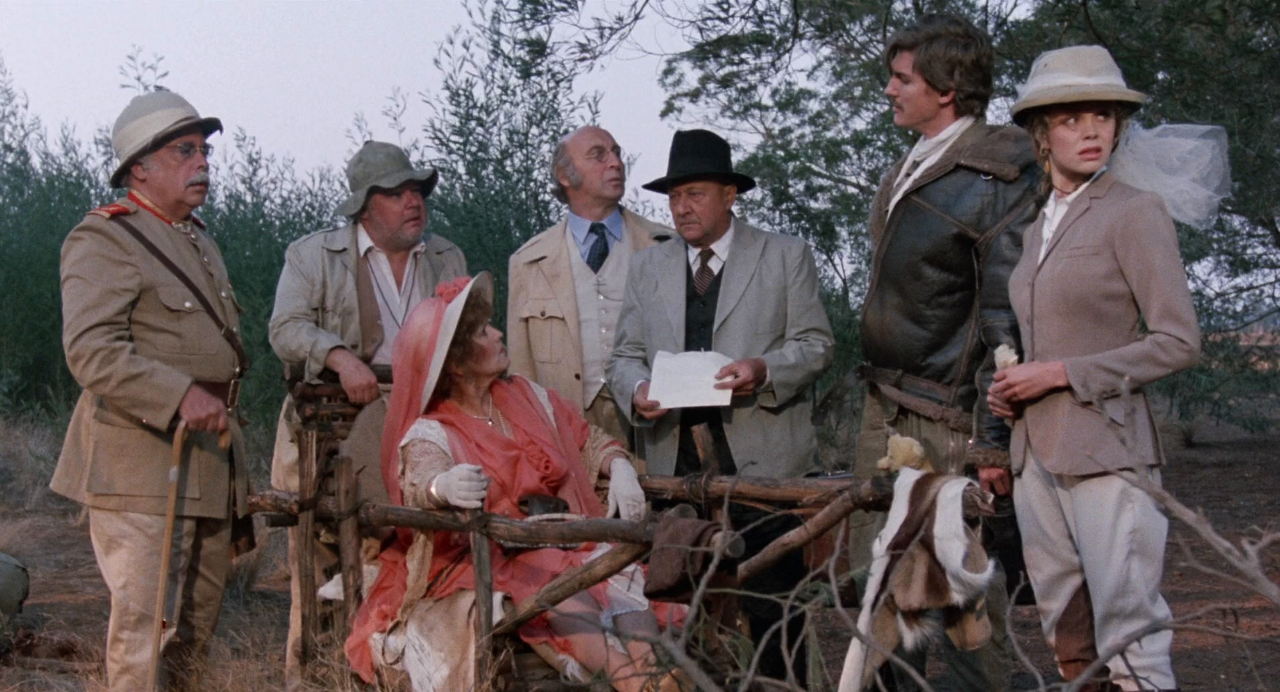Ten Little Indians
Rating
![]()
Director
Alan Birkinshaw
Screenplay
Jackson Hunsicker, Gerry O’Hara
Length
1h 40m
Starring
Donald Pleasance, Brenda Vaccaro, Frank Stallone, Herbert Lom, Sarah Maur Thorp, Warren Berlinger, Yehuda Efroni, Neil McCarthy, Moira Lister, Paul L. Smith
MPAA Rating
PG
Review
With the Russian version barely having made a blip, it was time for the last of the big screen adaptations of Agatha Christie’s seminal work. Ten Little Indians stretches even her clever prose to the breaking point with a miscast, deluded, and generally unenjoyable affair.
Set in a remote part of Africa on safari, a seemingly unrelated group of people are gathered by a mysterious malefactor who reveals that their past misdeeds have caught up with them and one-by-one they will be punished. The four most famous cast members are Donald Pleasance, Brenda Vaccaro, Herbert Lom, and Frank Stallone, Sylvester’s brother. Vaccaro and Lom were workmen actors whose performances were always worth watching while Pleasance was working regularly in the shadow of Halloween and its sequels. Stallone (Frank) was an odd choice to play the male lead and, with him, an unknown actor Sarah Maur Thorp, the end result was uninspired. This was also Lom’s second appearance in an adaptation of this source, having moved from playing the doctor in the 1974 version to playing the general in this one.
While the isolation of prior films is always keenly felt, the African Veld is far too open for the tense, cramped claustrophobia that makes And Then There Were None such a compelling production. Perhaps under a more skilled writer, the ingenuity of the premise would have come through, but the killings are rote and unimaginative. If the performances don’t crater your expectations, that lack of creative energy will. This was the last adaptation producer Harry Alan Towers tried to make and it was the first he didn’t write. While one of his prior two adaptations worked well, even his basic screenwriting skills could have improved the wasted effort of screenwriters Jackson Hunsicker and Gerry O’Hara. Not even Christie’s source material could save this misguided mess.
For their part, Vaccaro and Lom do solid work and Pleasance is credible, but the rest of the cast range from forgettable (Maur Thorp) to terrible (Stallone). It wasn’t that there weren’t plenty of great actors available for Christie adaptations. Peter Ustinov was, at that time, on a stellar run playing Hercule Poirot in a series of big screen and small screen adaptations from Murder in Three Acts to Appointment with Death, all of which fielded exemplary and noteworthy casts. They could have picked up rising stars and veteran actors galore and while Vaccaro was certainly a catch, the chance of getting someone like Tom Cruise to head the cast would have added immense amounts of weight to it, but alas he was busy in his Oscar-caliber work at the time. That said, I doubt he would have considered it from a no-name director (Alan Birkinshaw) or writing talent like this.
You can trace a direct downward trajectory of quality in Towers’ three productions. His first stab in 1965 was atmospheric, moody, and inventive. The cast was terrific and they had plenty of strong material to work with. The 1974 version had mediocre performances, decent but not exceptional direction, and a screenplay that was a bit worn but a setting that still managed to create dramatic tension. Now, with this 1989 misstep, Towers’ legacy faded to tatters with weak performances, unappealing setting and production values, and a screenplay that never should have been made. If you have a choice, don’t make this one yours. Stick with the 1945 original, the 1965 version, or the Russian one if you can.
Review Written
October 18, 2023



















Leave a Reply